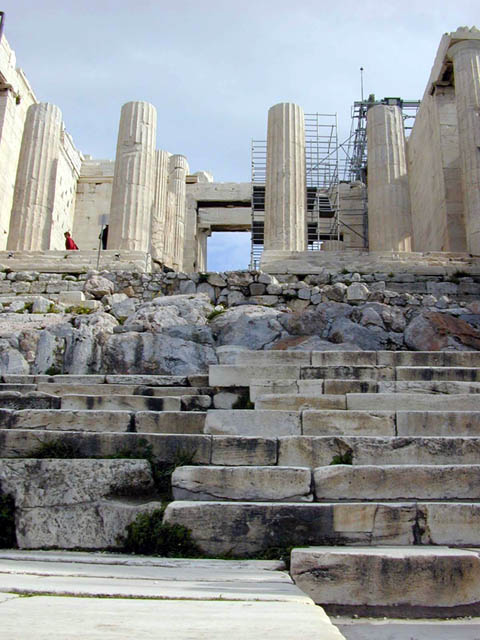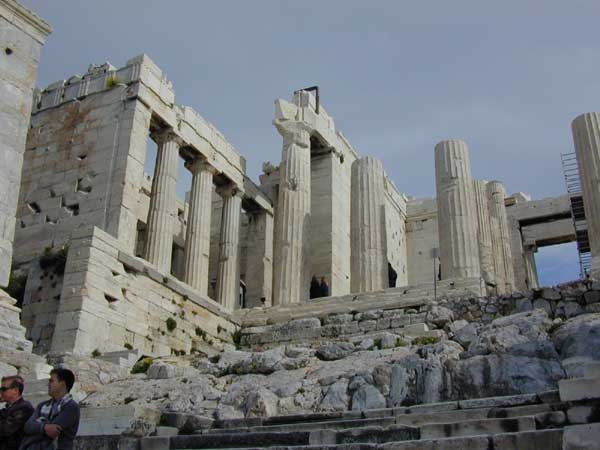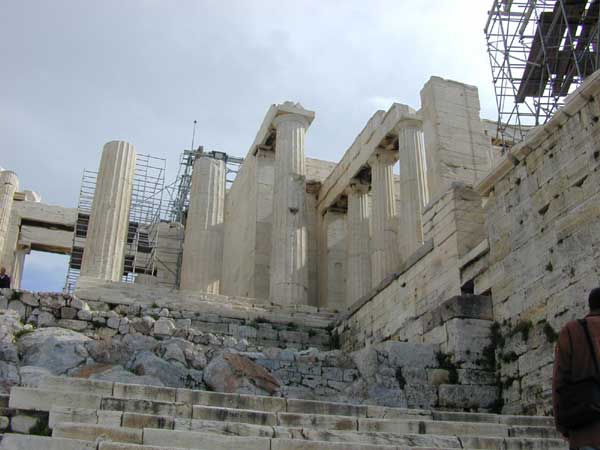The CSA Propylaea Project
Harrison Eiteljorg, II, 2013. https://doi.org/10.5284/1022574. How to cite using this DOI
Data copyright © Harrison Eiteljorg, II unless otherwise stated
This work is licensed under the ADS Terms of Use and Access.
Primary contact
Harrison
Eiteljorg, II
Center for the Study of Architecture
Box 60
Bryn Mawr
PA 19010
USA
Resource identifiers
- ADS Collection: 1591
- DOI:https://doi.org/10.5284/1022574
- How to cite using this DOI
Final Report, CSA Propylaea Project: Scholars' Introduction
Welcome to the introduction to the CSA Propylaea Project. This page is a part of the Final Report, of the project and is intended for use by scholars and others with a deep interest in the project and the Propylaea. The CSA Propylaea Project was a cooperative project intended to create a single digital resource of information about the Propylaea, the building at the entrance to the Athenian Acropolis. Initially conceived by Harrison Eiteljorg, II, Director of the Center for the Study of Architecture (CSA) in 1999; the project was also defined by the archaeologist/architect in charge of anastylosis work on the Propylaea, Tasos Tanoulas, and the structural engineer who worked on the Propylaea and later became the Director of the Acropolis Restoration Service, Maria Ioannidou.
In the summer of 2000 the CSA Propylaea Project received a very generous grant from the Samuel H. Kress Foundation to support the work, and progress was being made when the project was terminated toward the end of 2008. Mr. Tanoulas had determined that any new data generated by the project would necessarily belong to the Greek government and that, as a result, future information about the project could not be made freely available over the Internet. Access to such data would instead require the approval of the Greek Ministry of Culture. Since open access to project information had been a part of the project proposal, Mr. Eiteljorg and the Board of Directors of CSA recommended that the project be terminated; officials of the Kress Foundation agreed that the change made it impossible to continue the project according to its original plan. The project was then terminated. (Unused funds were returned to the Kress Foundation.) Nevertheless, the data presented here can be integrated with other data concerning the Propylaea, should such other data become available in the future, as all interested in the building and its history hope. In addition, work to improve our understanding of architectural planning in antiquity continues in the form of discussions on web pages and an equivalent blog, which may lead ultimately to a publication on this matter. These discussions utilize information gleaned from this project as well as other sources; links to the web pages and the blog may be found at the CSA Propylaea Project home page.
The CSA Propylaea Project Website existed to lead to information about the building in the forms of CAD models, photographs, raw data in various forms, drawings, and text. Since one aim of the project was to serve as a paradigm for similar attempts to gather and make available digital data about important buildings of the past, information about the processes used in the project, problems encountered, and resulting recommendations was to be a part of the results. One of the intentions was to make certain that the data gathered by the project team remained available to interested persons indefinitely. As a result, the materials available via the website have been transferred to the Archaeology Data Service (ADS). This web page is a part of the materials transferred. It contains both general information and links to further documentation required for the effective use of the data collected and made available here, as well as information needed to access the files. There are also links to discussions of the technologies and techniques used in the project. To request further information, please feel free to write to CSA Director, Harrison Eiteljorg, II, at CSA (P.O. Box 60, Bryn Mawr, PA 19010, USA or by email to user nicke at (@) the domain csanet.org.) To comment about any materials presented here or the manner of their presentation, please use the same addresses. Given the aims of the project, comments about the web materials will be greatly appreciated.
Links to more specific documentation follow.
- A page entitled Background and Rationale and intended to introduce the project to the general public.
- A history of the project.
- Photographs of the Propylaea. Photographs may be found and accessed via two plans of the Propylaea at this slide access page.
Thumbnails are used to provide previews and to help users find the images they wish to examine in more detail, but the actual images are served as very high-resolution, compressed JPEG images. For more information about the images, see the slide access page. In addition, information about the database containing data about the images is available from the this page.
- Information about and access to the database used to record information about the work on the NW wing of the Propylaea and to generate other files when required. The database files (in the form of .CSV files for the tables created) may be accessed via the guide to the database page, which also has documentation necessary to make the files useful.
- Scans of the notebook pages recording the survey work on the NW wing. See the survey notebook page for more information and access to the PDF files containing the scans.
- Full information concerning the CAD files may be found via the CAD models page. Users will need to spend considerable time becoming familiar with the information there before attempting to use the files. All the files are in AutoCAD 2007 format (regrettably, a proprietary format)..
- Information about survey methods used in the course of the project.
- Scans of drawings of the blocks of the SE anta and the nearby column and of various blocks/walls/tiles from the NW wing of the Propylaea are available only by request to Harrison Eiteljorg, II, Director of the CSA Propylaea Project. These files will not be archived at the Archaeology Data Service. Similarly, files produced by the 3D scanning work carried out in 2004 (in the proprietary format developed by Cyrax, the scanner manufacturer prior to the sale of the company to Leica) and files derived from the scanning files are available only via Mr. Eiteljorg. These files will not be archived because they are believed (by Mr. Eiteljorg) to require personal contact between any user and Mr. Eiteljorg for them to be used effectively. Mr. Eiteljorg may be reached by email at the user-name nicke at the domain csanet.org. (See the csanet.org website for more information.)
In addition, there is a very basic introduction to the Propylaea. It includes a beginning bibliography and a simple plan of the Propylaea.
Finally, there are many articles in the CSA Newsletter concerning the project. They are listed on the publications page, as are other publications resulting from the project and lectures about the project and/or information derived from the project.

The Propylaea from below.
(Digital photograph; February, 2000)
Since one aim of the project was to serve as a paradigm for similar attempts to gather and make available digital information about important buildings of the past, information about the processes used in the project, the problems encountered, and resulting recommendations has been included in the documentation. In fact, that information about processes, both successful ones and problematic ones, is one of the most important fruits of the project.
Given the intention that the project serve as a paradigm, readers' comments about the materials presented here and the form of their presentation are very much encouraged. When possible, such comments will be published via the CSA Newsletter.

The northwest wing of the Propylaea from below.
(Digital photograph; February, 2000)
Various materials regarding the predecessor of the Propylaea, the so-called older propylon, were available at the website of the CSA Propylaea Project, but those materials have been archived at the Archaeological Research Institute of Arizona State University and may be found at this URL: https://www.asu.edu/. These materials are no longer available at the propylaea.org web site, though Mr. Eiteljorg may be reached via email or telephone to comment upon or discuss relevant matters involving the older propylon.

The southwest wing of the Propylaea from below.
(Digital photograph
taken in February, 2000)
A final comment regarding the long-term availability of these materials must be made here. This document is part of the Final Report, of the CSA Propylaea Project, but proper long-term preservation of these materials requires much more than a relatively simple website. Preservation of the materials requires an active archival repository, and the materials you are accessing are those archival files as deposited with the Archaeology Data Service.
- Title: "Final Report, CSA Propylaea Project: Scholarsâ Introduction
- Author: Harrison Eiteljorg, II and the staff of CSA, Box 60, Bryn Mawr, PA 19010, (e-mail: user nicke at (@) the domain csanet.org; tel.: 484-612-5862)
- Original file name: indexs.html
- Revision history: Since this document is part of the CSA Propylaea Project Final Report and has been archived with the Archaeology Data Service, changes should not occur. Serious mistakes may be corrected; if so, clear indications of corrections will be included. While preliminary versions of this document were on the project website and much of the content of this document was included in the original home page of the site, the version represented here was not previously posted. It was prepared in 2011 and updated in the process of preparing project materials for archival preservation in June of 2013.
- Internet access: This document was first prepared for propylaea.csanet.org, operated by the Center for the Study of Architecture and Harrison Eiteljorg, II. It has been turned over to the Archaeology Data Service for archival preservation.
- Long-term availability: This document or its successors will be maintained for electronic access indefinitely.





